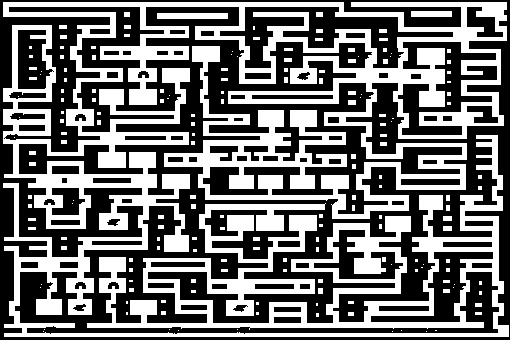HACKING AT THE WULF |
The encounters that followed had me being trampled by hippos, rhinos, and other lesser beasts (including several frogs - probably revenge for what I did to them in Frogger!) and only once did I see the Wulf himself as he flattened me from behind. This finally persuaded me that immortality would be a very desirable commodity. I postponed my quest for the Amulet and instead, with a cry of 'Hacking Away', leapt headlong into the machine code jungle in search of the fabled 'infinite lives' POKE.
BREAKING POINT
The first obstacle I had to get past was the fact thatHaving done the necessary, I resumed my search for the POKE, and in the course of finding it (in fact, I found two but one of them is not strictly necessary) I discovered that (due to the way the number of lives that you have left is printed out) you are limited to a maximum of nine lives at a time and any extra lives you gain above this number are ignored. However, having found the POKE for infinite lives I decided to have a quick gander at the rest of it.
The program, as in most other games, is mostly data - but the data in Sabre Wulf is spread throughout the code instead of all being tucked away in one place, as is more usual. This seems to point to the supposition that Ultimate use teams of programmers each working on a separate aspect of the game. This
Apart from the data structure for the rooms (which I'll return to later) the program is not really outstanding ... just a very professional piece of coding, even if it does occasionally use self-modifying code. (For non-hackers, this is where a program changes its own instructions as it's running - something that's generally considered bad programming practice.)
THE JUNGLE POKE
I discovered that the maze is 16 by 16 rooms in size and that there are 48 different room types within it. Each of these rooms is constructed by using separate 'data blocks' that are stuck together in different forms to produce each room; one example of such a data block is the lake that appears at various places in the jungle. I didn't count how many blocks are used in total, but I'd guess there are over a hundred - perhaps even a couple of hundred; someone at Ultimate must have very sore typing fingers from entering all that lot!The outcome of this is that with just a few POKEs I managed to move and remove large chunks of foliage; given time (and a good keyboard) it should be possible to re-design the whole thing and have your own personalised jungle to run about in. I also considered finding a POKE that would allow me to stay cyan all the time - thus speeding up the game (as well as making me indestructible!). However, on reflection I decided that it probably wasn't really worth it. The decision later proved to be right. After about three hours searching, I finally managed to find all the bits of the Amulet and escape, making Sabre Wulf the first Ultimate game that I have been able to beat - even if I did have to cheat slightly.

The playing area comprises 256 screens that link up to form an intricate 16 by 16 maze; there are, in fact, only 48 different types of 'room' though when joined together they all look unique. The four pieces of the amulet are hidden in various places in the maze and, once you've found them all, you'll have to battle your way back to the home of the unfriendly statue. Watch out for the jungle path - two paths up from the bottom of the playing area - that's the lair of the Wulf!